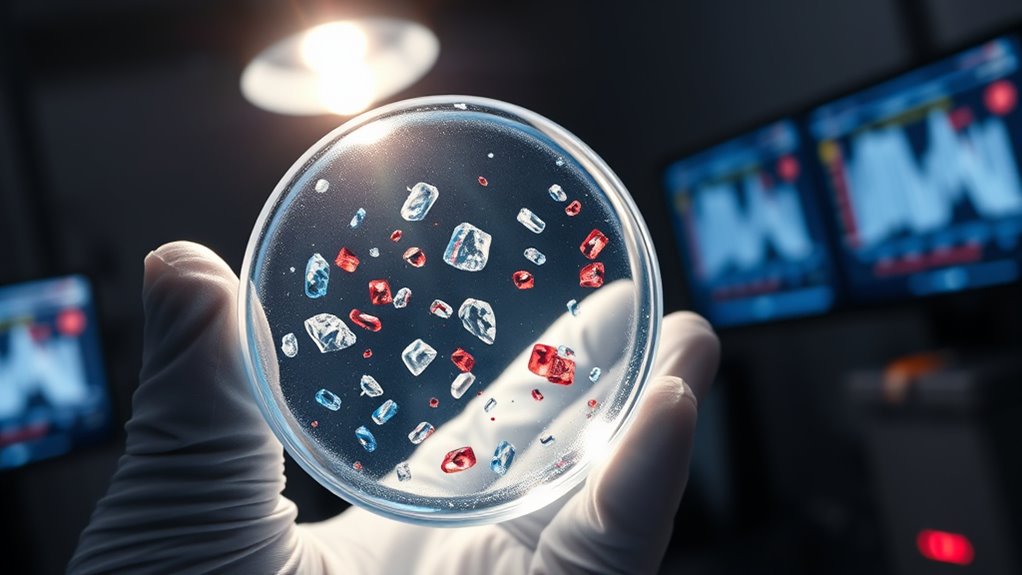By 2025, products are actively fighting microplastic pollution through innovative filters in washing machines, eco-friendly redesigns, and biodegradable packaging. You can support these efforts by choosing brands committed to reducing plastic waste and staying informed about microplastic formation. Consumer awareness plays a crucial role in encouraging companies to develop sustainable solutions. Keep exploring to discover how these advancements can help protect the environment and guarantee a cleaner future for everyone.
Key Takeaways
- 2025 products incorporate built-in microplastic filters in appliances like washing machines to capture tiny particles before they reach the environment.
- Reformulated personal care items eliminate microbeads, reducing microplastic shedding at the source.
- Innovative packaging and biodegradable materials help decrease plastic waste and microplastic fragmentation.
- Consumer awareness drives demand for eco-friendly products, encouraging companies to prioritize sustainable design and transparency.
- Collective efforts and technological advancements aim to significantly reduce microplastic pollution, ensuring a cleaner environment for future generations.

Microplastics are tiny particles polluting our environment, and tracking them has never been more important. As these minuscule pollutants infiltrate oceans, rivers, and even the air we breathe, understanding their impact becomes essential. You might not see microplastics with the naked eye, but their presence is undeniable, and their environmental impact is profound. They threaten marine life, disrupt ecosystems, and potentially enter our food chain through seafood consumption. Recognizing this, 2025 products are taking innovative steps to address the microplastic problem, but your role as a consumer is vital too. Increased consumer awareness is fueling demand for sustainable alternatives and pushing companies to prioritize eco-friendly practices. When you choose products that minimize plastic use or incorporate microplastic filters, you contribute to reducing the overall burden on the environment.
These new products are designed with the environment in mind, aiming to prevent microplastic shedding at the source. For instance, many washing machines now come with built-in microplastic filters that capture fibers released during laundry, preventing them from entering waterways. Similarly, personal care items like exfoliating scrubs are being reformulated to eliminate microbeads, which are notorious microplastic culprits. Your awareness of such innovations encourages brands to develop and promote eco-conscious products, creating a ripple effect that benefits the planet. Companies are also investing in biodegradable packaging and materials that break down faster, reducing plastic waste that can fragment into microplastics over time.
Understanding the environmental impact of microplastics helps you make smarter, more responsible choices. As a consumer, you hold significant power—your purchasing decisions influence manufacturing trends and product development. When you support brands committed to reducing plastic pollution, you’re directly contributing to a cleaner environment. Educating yourself about how microplastics form and spread not only enhances your awareness but also empowers you to advocate for policies that protect ecosystems. By staying informed and demanding transparency from companies, you help accelerate the shift toward sustainable products that lessen microplastic pollution. Additionally, learning about the types of microplastic filters available can guide your choices in supporting eco-friendly innovations.
In the end, the fight against microplastics isn’t just about new products; it’s about changing habits and perceptions. Your consumer awareness drives innovation, encourages corporate responsibility, and ultimately leads to a healthier planet. With every purchase, you have the opportunity to support solutions that minimize environmental impact, making a tangible difference in the ongoing microplastic hunt. The collective effort of informed consumers and forward-thinking companies could turn the tide on this tiny but mighty pollutant, securing a cleaner, safer environment for generations to come.
Frequently Asked Questions
What Are Microplastics’s Long-Term Effects on Human Health?
You might wonder about the long-term health effects of microplastics, especially with chronic exposure. Research suggests these tiny particles can accumulate in your body, potentially causing inflammation, hormonal disruptions, and even affecting your immune system over time. While scientists are still studying the full impact, reducing your exposure now can help protect your health in the long run. Being aware and cautious is key to safeguarding your future well-being.
How Can Consumers Identify Microplastic-Free Products?
To identify microplastic-free products, look for labelled packaging that clearly states ingredients and ingredients transparency. Read labels carefully and choose brands committed to eco-friendly practices. Trust products with certifications or eco-labels indicating minimal plastic use. Avoid vague claims and seek out information from the manufacturer if needed. Your attentiveness helps support products that are free from microplastics, making a positive impact on your health and the environment.
Are There Any Regulations Limiting Microplastic Use in Products?
Ever wondered if there’s a limit to microplastic use? While industry standards are evolving, regulations vary by country, and international agreements aim to reduce microplastic pollution. Some regions enforce bans or restrictions on microbeads and microplastic-containing products, but global enforcement isn’t uniform. You can stay informed about local laws, support brands committed to eco-friendly practices, and advocate for stronger regulations to help curb microplastic pollution worldwide.
How Effective Are Current Microplastic Filtration Technologies?
You wonder how effective current microplastic filtration technologies are. Filtering technologies have improved, capturing larger microplastics effectively, but smaller particles often slip through. Effectiveness evaluation shows varying success rates depending on the system, with some advanced filters achieving over 90% removal efficiency. However, ongoing research aims to enhance these technologies further, ensuring they can reliably filter even the tiniest microplastics, making your water safer and reducing environmental impact.
What Roles Do Governments Play in Microplastic Pollution Reduction?
Imagine governments as gatekeepers, balancing policy initiatives and international collaborations to fight microplastic pollution. You see them drafting regulations that limit plastic waste and funding research to develop better filtration tech. They also work across borders through international collaborations, sharing data and strategies. Their role is vital—by setting standards and fostering cooperation, they create a unified front, making it easier for communities and industries to reduce microplastic emissions effectively.
Conclusion
As you consider the efforts of 2025 products, remember they’re gently steering us toward clearer waters and healthier shores. Though tiny, these pollutants whisper of bigger challenges ahead, urging us to stay mindful and proactive. By embracing these innovations, you’re part of a quiet revolution, helping to tidy up our world’s delicate fabric. Every small step counts, guiding us toward a cleaner, brighter future—one subtle change at a time.









